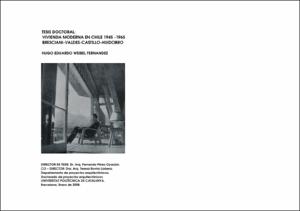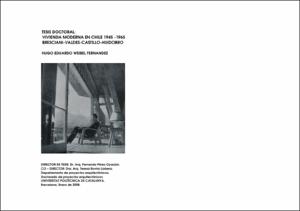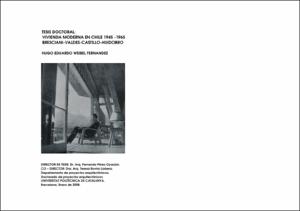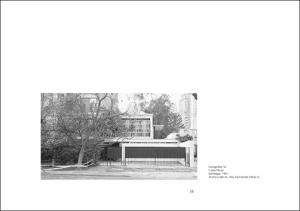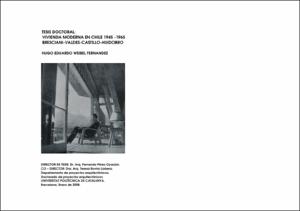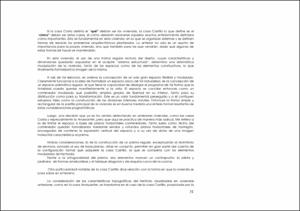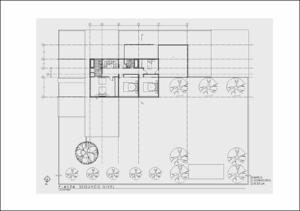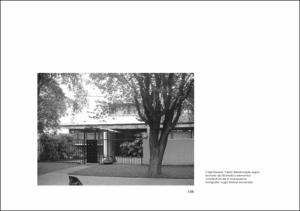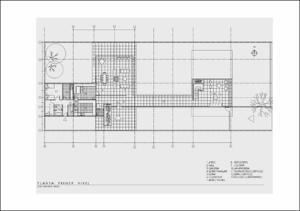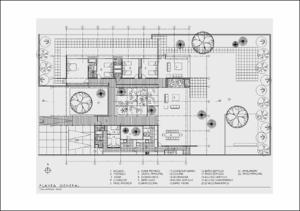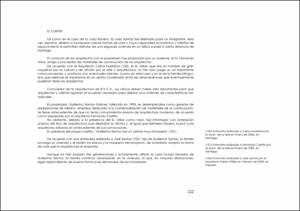Mostra el registre d'ítem simple
Vivienda moderna en chile 1945-1965, Bresciani, Valdes, Castillo, Huidobro
| dc.contributor | Pérez Oryazun, Fernando |
| dc.contributor | Rovira Llobera, Teresa |
| dc.contributor.author | Weibel Fernández, Hugo Eduardo |
| dc.contributor.other | Universitat Politècnica de Catalunya. Departament de Projectes Arquitectònics |
| dc.date.accessioned | 2011-04-12T15:25:15Z |
| dc.date.available | 2009-03-20 |
| dc.date.issued | 2008-11-10 |
| dc.date.submitted | 2009-03-12 |
| dc.identifier.citation | Weibel Fernández, H.E. Vivienda moderna en chile 1945-1965, Bresciani, Valdes, Castillo, Huidobro. Tesi doctoral, UPC, Departament de Projectes Arquitectònics, 2008. ISBN 9788469225103. DOI 10.5821/dissertation-2117-94127. |
| dc.identifier.isbn | 9788469225103 |
| dc.identifier.other | http://www.tdx.cat/TDX-0312109-125043 |
| dc.identifier.uri | http://hdl.handle.net/2117/94127 |
| dc.description.abstract | El objeto de estudio de esta tesis es la vivienda unifamiliar de la oficina chilena Bresciani, Valdés, Castillo, Huidobro. <br/>Dentro del conjunto de su obra, dicha temática -que dio origen a sus encargos y cuyo diseño tuvo una regularidad prácticamente ininterrumpida durante toda su trayectoria- puede ser vista como un claro y representativo objeto de estudio y una pieza fundamental de su "laboratorio" de arquitectura, fundado a partir de una concepción vanguardista, basada en los postulados del movimiento moderno.<br/><br/>Una primera hipótesis planteada señala que tales diseños fueron desarrollados atendiendo a la ecuación de evolución y continuidad, ecuación sobre la cual se habrían sentado las bases de la construcción de su propia línea de acción. Pero dicha ecuación no hubiera sido completamente fructífera si es que la oficina no hubiese contado con la adecuada elección y utilización de aquellos recursos arquitectónicos modernos que les permitieran una interpretación local. Así, surge una segunda hipótesis, que señala que la vivienda unifamiliar moderna, diseñada atendiendo a la ecuación de evolución y continuidad, fue paralelamente dotada de los mecanismos y la flexibilidad necesaria para adecuarse a las condicionantes y particularidades locales.<br/><br/>Inicialmente, en el primer capítulo de introducción, se expresaron algunas interrogantes y se enunciaron los objetivos, a la vez que se dejaron sentadas las bases de la metodología de investigación utilizada y se plantearon las hipótesis.<br/><br/>En un segundo capítulo, se expuso un panorama general de la arquitectura de vivienda unifamiliar moderna, tanto latinoamericana como chilena, del período de estudio que va entre 1930 y 1965, el que incluyó tanto su estado de situación y particularidades como a los protagonistas y sus obras. Este capítulo permite situar el escenario en que se desarrolla la obra de la oficina estudiada.<br/><br/>Luego, en un tercer capítulo, se presentó una visión general acerca de la oficina estudiada: primeramente se presentó a sus integrantes, luego se estableció la naturaleza de los vínculos observados entre ellos, posteriormente se señaló las fuentes de los referentes de su labor, se enseñó su quehacer arquitectónico; su trayectoria y obra destacada, y, finalmente, se determinó el rol que tuvo la temática de vivienda dentro de ella. <br/><br/>Posteriormente, un cuarto capítulo enfocó en el tema de la vivienda unifamiliar diseñada por la oficina, estableciéndose el lugar que dicha temática ocupaba dentro de su obra y evidenciando su importancia relativa. Asimismo, aquí se hizo una revisión cronológica de ejemplos de viviendas unifamiliares de la oficina y se establecieron los períodos en los que tal producción se puede clasificar.<br/>En el capítulo quinto se efectuaron los análisis a seis viviendas unifamiliares representativas del período estudiado. El asunto que enfocó el interés fue el de reconocer los criterios y valores que emanaban de las obras mismas, en orden a verificar las hipótesis planteadas.<br/><br/>En el capítulo seis, se concluyó la investigación y se dejó planteada la posibilidad de revisar con mayor profundidad esta y otras facetas significativas de la obra de la oficina estudiada. Finalmente, se expusieron los textos anexos y se hizo referencia a las fuentes de investigación.<br/><br/>Este trabajo debe ser visto como una contribución al esfuerzo mayor de profundizar en el conocimiento de la historia de la Arquitectura Moderna latinoamericana, emprendida a través del estudio de la particular experiencia de una oficina chilena, diseñando en Chile a mediados del siglo pasado, ayudando así a esclarecer y difundir algunas de las formas en las que este movimiento cristalizó en esta parte del planeta. |
| dc.description.abstract | This thesis subject matter deals with the Chilean Firm Bresciani, Valdés, Castillo, Huidobro single -member house Project. <br/><br/>Within the spectrum of its work, such issue - which gave birth to its orders and whose design had a practically complete uniformity all the time - can be seen as a clear and representative subject matter and a crucial issue of its architecture "laboratory", grounded from a pioneering understanding, based on the principles of the modern movement.<br/><br/>The first proposed hypothesis points out that such designs were developed taking into account the evolution and continuity equation upon which the basis of the construction of its own line of action would be set. Nonetheless, such equation wouldn't have been completely succesful if the firm had not had the right choice and use of such modern architectonic resources which allow it a local interpretation. Thus, a second hypothesis appears, which points out that a modern single - member house, developed taking into account the evolution and continuity equation was concomitantly endowed with the mechanisms and flexibility necessary to fit the local constraints and peculiarities.<br/><br/>Initially, in the first introduction chapter, some questions were expressed and the objectives enunciated; at the same time, the basis of the investigation methodology used was set and the hypothesis was posed.<br/><br/>In the second chapter, a general view of the architecture of the modern Chilean as well as Latin - American simgle - member house of the study period, betwen 1930 and 1965 was exposed, this incluided its status report and peculiarities as well as the protagonists and their works. This chapter places the scenario in which the work of the studied firm is developed.<br/><br/>Then, in the third chapter, a general view of the studied firm was presented. The members were introduced in the first place, then, the nature of the relationship observed between them was established; subsequently, the sources of the referents of their work were pointed out, their architectonic chores were showed, its record of achievement and work underlined, and finally, the role that the housing theme had within it was determined.<br/><br/>Then, the fourth chapter focused on the single - member house theme designed by the firm, establishing the importance that such issue had within its work and showing its relative importance. Similarly, a chronological review of the examples of the firm's single - member house was carried out and the phases in which such production can be classified were established.<br/><br/>In the fifth chapter, the analysis to six representative single - member houses of the studied period was made. The issue intended to recognize the criteria and the values that derived from the works themselves so as to verify the hypothesis proposed.<br/><br/>The investigation concluded in the chapter six. Here, the possibility of a further checking of this and other major facets of the studied office's work were proposed. Finally, the adjunct texts were exposed and the sources of investigation were mentioned.<br/><br/>This work must be seen as a contribution to the major effort of going deeply into the knowledge of the history of Latin - American Modern Architecture, which was undertaken through the study of the particular experience of a Chilean firm which designed in Chile around the middle of the past century, helping in a way to clarify and spread some of the ways in which this movement crystallized in this corner of the planet. |
| dc.language.iso | spa |
| dc.publisher | Universitat Politècnica de Catalunya |
| dc.rights | ADVERTIMENT. L'accés als continguts d'aquesta tesi doctoral i la seva utilització ha de respectar els drets de la persona autora. Pot ser utilitzada per a consulta o estudi personal, així com en activitats o materials d'investigació i docència en els termes establerts a l'art. 32 del Text Refós de la Llei de Propietat Intel·lectual (RDL 1/1996). Per altres utilitzacions es requereix l'autorització prèvia i expressa de la persona autora. En qualsevol cas, en la utilització dels seus continguts caldrà indicar de forma clara el nom i cognoms de la persona autora i el títol de la tesi doctoral. No s'autoritza la seva reproducció o altres formes d'explotació efectuades amb finalitats de lucre ni la seva comunicació pública des d'un lloc aliè al servei TDX. Tampoc s'autoritza la presentació del seu contingut en una finestra o marc aliè a TDX (framing). Aquesta reserva de drets afecta tant als continguts de la tesi com als seus resums i índexs. |
| dc.source | TDX (Tesis Doctorals en Xarxa) |
| dc.subject | Àrees temàtiques de la UPC::Arquitectura |
| dc.subject.other | vivienda moderna Chile |
| dc.title | Vivienda moderna en chile 1945-1965, Bresciani, Valdes, Castillo, Huidobro |
| dc.type | Doctoral thesis |
| dc.subject.lemac | Habitatges unifamiliars -- Xile -- Història -- S. XX |
| dc.subject.lemac | Arquitectura domèstica -- Història -- S. XX -- Xile |
| dc.subject.lemac | Arquitectes -- Xile |
| dc.identifier.doi | 10.5821/dissertation-2117-94127 |
| dc.identifier.dl | B.23590-2009 |
| dc.rights.access | Open Access |
| dc.description.version | Postprint (published version) |
| dc.identifier.tdx | http://hdl.handle.net/10803/6817 |
Fitxers d'aquest items
Aquest ítem apareix a les col·leccions següents
-
Departament de Projectes Arquitectònics [208]
-
Totes les tesis [5.446]


